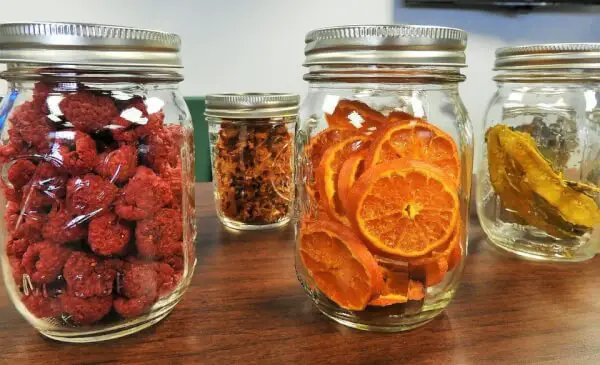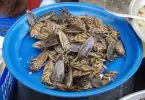Outdoorsmen love nature and are always looking for ways to extend their stay in the woods. However, bringing food to last weeks or months on your own can be a problem. We all know that carrying a large amount of food when your backpacking or camping is a problem because more food means a bigger and heavier load. Yes, it is possible to catch food through hunting or fishing but the problem is preserving the food so you it doesn’t spoil.
Luckily, there ways to preserve food and make them last longer. Dehydration is one of the oldest and easiest ways of food preservation which is why we need to learn how to dehydrate food so that we can enjoy nutritious food in the woods or at home.
Food drying or dehydration is the process of removing water in food so that the growth of bacteria, yeast and mold is inhibited. Once food is dehydrated it can be stored indefinitely so that you can extend your stay outdoors or always have a store of rations that you can rely on during survival situations or emergencies at home. There are many ways to dehydrate food but there are also methods that do not require fancy equipment making it perfect for outdoorsmen, backpackers and campers.
Making your own dehydrated food has a lot of benefits. First of all, it tastes great unlike dehydrated food that you buy in the grocery food. It is also less expensive and healthier than buying process snacks. Backpackers for example, can hike for long periods of time without stopping. They rely on dehydrated snacks for energy. This means that you need to buy a lot of dehydrated food and the price can add up if you’re an avid backpacker.
Making your own can help save you money and you’re ensured that you’re only using the best and healthiest foods. Lastly, dehydrating food cuts waste. Americans waste $165 billion worth of food every year due to spoilage. Dehydrating foods preserves them so that you can enjoy them later.
It can be difficult to find healthy food on the go. This is a problem for many backpackers and campers who have limited space to carry or store their food. Bananas are great but they don’t last long and you can only carry a limited amount before they go bad. In this article we will talk about the different ways you can dehydrate food so that you can preserve them for camping or hiking or for emergency situations like calamities or for survival mode.
Different Ways To Dehydrate Food
Dehydrating food is a good way to save money because dehydrated food has a longer shelf-life. Aside as rations for camping, dehydrating food is a great way to any excess fruits, veggies and meat you have at home. Dehydrating food is great for extra tomatoes, apples, mushroom and other fruits while retaining most of their nutritional value. It makes many fruits ideal for snacking or for adding them to oatmeal, muffins or soup. Dehydrating is also a great option for herbs because it preserves them when they’re not in season while bringing out their strongest flavors.
There are many ways you can dehydrate your food. Here are some of the easiest and popular ways to preserve your food.
Oven
Yes, your oven at home can be used to dehydrate your food. Dehydration is basically removing the water in food and the heat of your oven can do this without thoroughly cooking or burning food. Using your oven also means that you don’t have to buy fancy dehydrators while making use of appliance you already have at home.
Using your oven to dehydrate food is very easy. First you need to cut or slice your food thinly. If you’re dehydrating apples for instance, you need to slice them thinly and put them on a lined sheet pan. Turn your oven to the lowest setting and they’re usually done after around 6 to 8 hours.
If you don’t have 6 to 8 hours to spare you can bump your oven up to 225°F but the high temperature can cook some fruits and veggies so they’re not really traditionally dehydrated. However, this temperature is recommended for apples. If you’re using this setting your apples will be done in approximately 2 hours depending on how thinly they are sliced.
Oven Toaster
If you can’t spare your oven for long periods you can opt to use your oven toaster instead. The same process can be followed when using an oven you just need to crack the door open a bit to prevent condensation. Oven toasters vary from manufacturer to manufacturer so temperature settings are usually not the same. Just like ovens you just need to turn the setting to the lowest temperature and to check your food periodically and you will have a perfect snack.
Sun Dried
Sun drying food is perhaps the oldest way to dehydrate food. Sun drying is a great option for herbs and tomatoes which get sweeter the longer they are dried in the sun. For tomatoes and other fruits and vegetables, just slice them thinly and place them on a baking sheet. Find a good sunny place to leave them until they’re perfect.
Sun drying food usually takes a couple of days depending on the food and the temperature. You will need to device a mesh covering or buy a mesh netting to prevent flies from getting in your food.
Dehydrators
You can also use a dehydrator to dry your food. It is basically an appliance that uses low heat to reduce the overall amount of water in your fruit, vegetable or meat. If it’s your first time to use a dehydrator make sure to read the instructions before using it. It is also advisable to dehydrate small quantities of food if it is your first time. Start with fruits and veggies before moving to chicken and meats.
When you’re using your dehydrator at home it is important to find a dry warm place away from vents or windows. High indoor humidity, air conditioning or breezes can alter the time needed to dehydrate your food.
If your food feels spongy, sticky or soft, stick them back inside the dehydrator for additional drying. Your food should be hard, crunchy and breakable so that they can be stored properly.
Food Dehydration Tips
Dehydrating your own food is cheap, easy and healthy. Food is more nutritious, portable and easier to store. If you want to dehydrate food, you have to learn how to do it correctly. If you’re using a dehydrator the first step is always to read and follow the instructions. Dehydrating food also takes trial and error especially for first-timers. This is why you should keep these tips in mind when dehydrating food.
- Different foods require different temperatures for dehydration. If you’re using a dehydrator make sure to consult the manual to know the right setting for the food you’re about to dehydrate. For example, meats usually require higher temperature compared to fruits and veggies.
If you’re using an oven, turn it to the lowest setting and check your food periodically. Drying time differs from food to food but you will know that food is done when it is hard, crumbly and crunchy.
- Don’t rush the drying process. You don’t have to worry about over-drying food because you can dry them longer than necessary. It is also not advisable to turn the temperature settings up in an attempt to make them dry faster. Turning the temp up will result in a dry outer layer with a moist center that can spoil the food even before you have a chance to eat it.
- Always prepare your food properly before dehydrating them. Wash your food thoroughly using anti-bacterial cleaner (for fruits and veggies only). You should also consider wearing gloves during the preparation process to prevent any skin oils from transferring to the food. You will also need to steam or blanch low acid foods 10 minutes before drying. Spray banana and apples with lemon juice to prevent browning.
- For ground beef, use lean or extra lean ground beef with fat content in the 7% to 15% range. Using low fat meat is better because it has lower risk of spoiling after it is dried. Check meat periodically for oil droplets and blot with paper towel while drying.
- For pork, use precooked ham with less than 10% fat. Cut ham into ¾ to 1” wide strips and like all meats, check periodically for oil droplets and blot with paper towel while drying.
- Use solid white tuna instead of tuna packed in oil. Just like meat, the oils in the tuna can up the risk of spoilage. Drain the water and break of the tuna into smaller pieces. Place the tuna in a lined tray or in a single layer on the dehydrator tray. Meats and tuna usually take approximately 6-8 hours to dry and tuna can stink up your house.
- You can dehydrate food and vegetables regardless of quality. The goal of dehydrating is to preserve and save so don’t be afraid to dehydrate bruised, over ripe or slightly damaged vegetables or fruits. If fruit or veggie is too soft, puree them and dehydrate the puree.
- Dehydrate food one family at a time. If you want to dehydrate tomatoes you can also dehydrate it together with peppers. However, you should beware that your tomatoes could end up spicy. Fruits can be generally mixed together but mixing them with strong tasting or strong smelling vegetables can alter their taste so it is not recommended.
- When drying fruits and vegetables, try to slice them to the same thickness to keep they dehydration even. Do not overlap pieces so as not to restrict airflow and prevent food from drying. The exception is greens since they are loose and dry easily and quickly. Just make sure not to pile on too many layers in one tray to make sure everything gets dehydrated.
- Dehydrate hot peppers or onions in a well-ventilated area. Scrub the trays and dehydrator thoroughly when you’re done. Oils in the peppers or onions can transfer to other foods so take care when cleaning your tools. Onions are more airborne than peppers so make sure that the area has lots of windows and vents.
- Berries can be a challenge since they are small but contained. Most berries can be dehydrated whole but large grapes should be cut in half before dehydration. You also need to check on your berries often since they have a tendency to over-dry. Make sure that they remain supple and slightly crispy.
- Proper storage is very important for any dried food. Consider vacuum sealing your food since air contains moisture that can compromise the integrity of your food. A vacuum sealer also prevents microbial growth and can extend the shelf-life of your dehydrated food.
- Label your dehydrated foods before storing them. It can be easy to get into food dehydration especially if you like to take advantage of sales or just like to stock up on food. It is also best to check their quality periodically especially when it comes to meats.
The National Center for Home Food Preservation recommends keeping dehydrated meats in an unrefrigerated area for no longer than 2 weeks.
After this you will need to refrigerate your meat. Hermetically sealed dried fruits and vegetables have a storage life of around 5-8 years provided that they are stored in a stable 70°F. They can be kept longer if stored in lower temperatures.
Wrap Up
Dehydrating food is a fantastic way to preserve it for future use. For outdoorsman, preserved food means more space inside backpacks and more time to spend outdoors. Aside from this, eating dehydrated food that you made is cheaper and healthier compared to buying store-bought processed foods. Dehydrating food extends shelf-life, prevents decay and growth of microorganisms and is a good alternative to canning or pickling food.
Learning how to dehydrate food is not only a great way to save money and prevent waste. It can also be used to make sure that your food can last a long time without compromising its nutritional value. This way you can enjoy nutritious food even if you’re hiking, camping or even during survival situations.
Featured Image Source: https://pixabay.com/photos/mason-jars-dehydrated-fruit-oranges-2742757/





